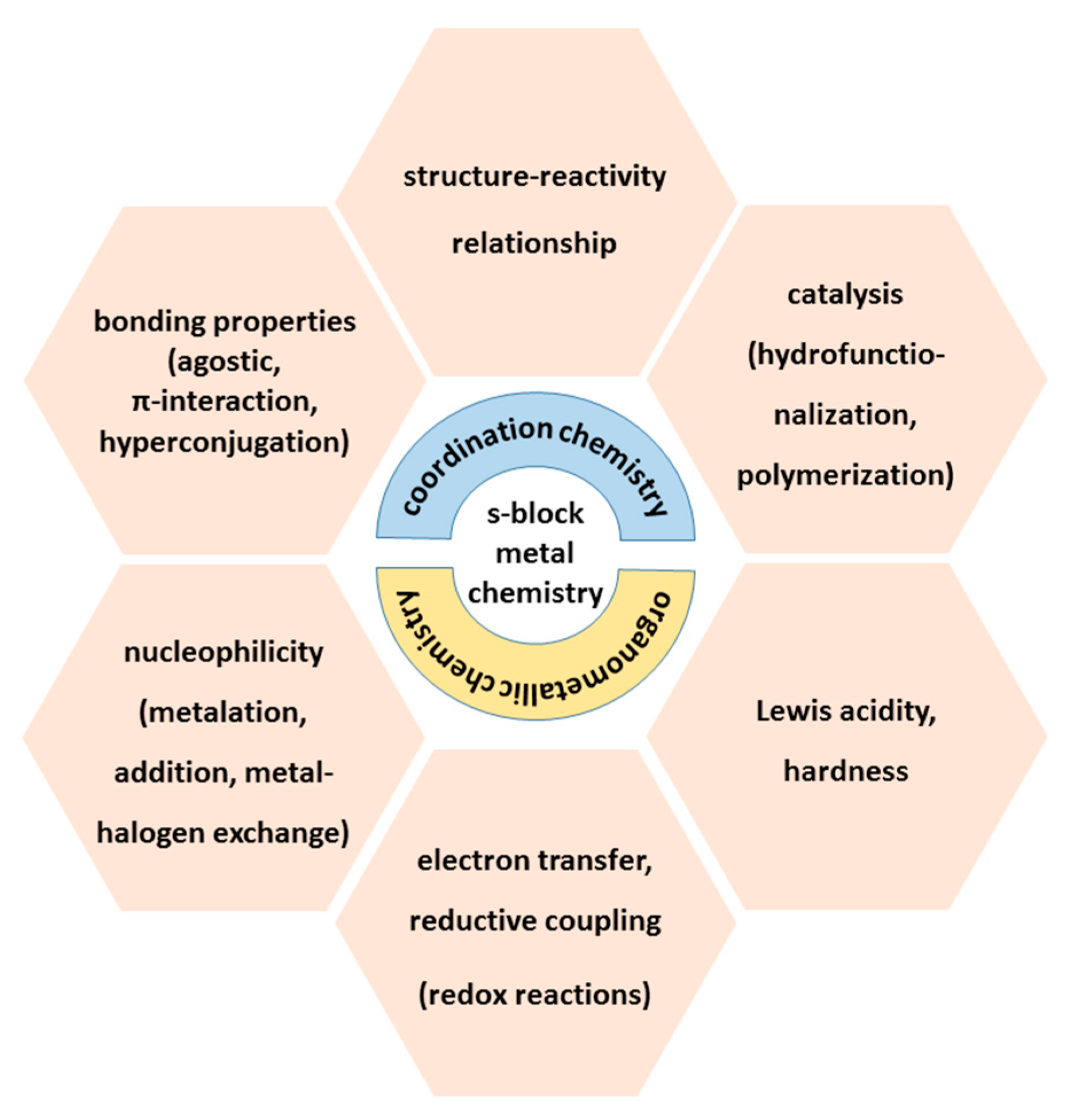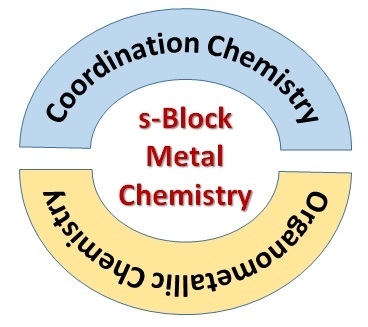Kudos and Renaissance of s-Block Metal Chemistry
Abstract
:Conflicts of Interest
References
- Emsley, J. The Elements; Clarendon Press: Oxford, NY, USA, 1989. [Google Scholar]
- Naglav, D.; Buchner, M.R.; Bendt, G.; Kraus, F.; Schulz, S. Off the beaten track—A hitchhiker’s guide to beryllium chemistry. Angew. Chem. Int. Ed. 2016, 55, 10562–10576. [Google Scholar] [CrossRef] [PubMed]
- Holleman, A.F.; Wiberg, E.; Wiberg, N. Lehrbuch der Anorganischen Chemie (Holleman-Wiberg), 102nd ed.; de Gruyter: Berlin, Germany, 2007. [Google Scholar]
- Stasch, A.; Jones, C. Stable Dimeric Magnesium(I) Compounds: From chemical landmarks to versatile reagents. Dalton Trans. 2011, 40, 5659–5672. [Google Scholar] [CrossRef] [PubMed]
- Krieck, S.; Görls, H.; Yu, L.; Reiher, M.; Westerhausen, M. Stable “inverse“ sandwich complex with unprecedented organocalcium(I): crystal structures of [(thf)2Mg(Br)-C6H2-2,4,6-Ph3] and [(thf)3Ca{µ-C6H3-1,3,5-Ph3}Ca(thf)3]. J. Am. Chem. Soc. 2009, 131, 2977–2985. [Google Scholar] [CrossRef] [PubMed]
- Hevia, E.; Mulvey, R. Towards a paradigm shift in the principles and practice of polar organometallic chemistry (EPSRC Fund). Available online: https://pure.strath.ac.uk/portal/en/projects/towards-a-paradigm-shift-in-the-principles-and-practice-of-polar-organometallic-chemistry(5f1b83e5-44b1-4993-8de8-4ea484510c7d).html (accessed on 10 March 2017).
- Seyferth, D. The Grignard reagents. Organometallics 2009, 28, 1598–1605. [Google Scholar] [CrossRef]
- Westerhausen, M.; Krieck, S. Magnesium. Available online: http://www.aktuelle-wochenschau.de/main-navi/archiv/chemie-der-elemente-2016/kw51-magnesium.html?gid=108266Andreas (accessed on 10 March 2017).
- Benischke, A.D.; Ellwart, M.; Becker, M.R.; Knochel, P. Polyfunctional zinc and magnesium organometallics for organic synthesis: Some perspectives. Synthesis 2016, 48, 1101–1107. [Google Scholar]
- Martínez-Martínez, A.J.; O’Hara, C.T. Lithium, sodium, and potassium magnesiate chemistry: A structural overview. Adv. Organomet. Chem. 2016, 65, 1–46. [Google Scholar]
- Harrison-Marchand, A.; Mongin, F. Mixed AggregAte (MAA): A single concept for all dipolar organometallic aggregates. 1. Structural data. Chem. Rev. 2013, 113, 7470–7562. [Google Scholar] [CrossRef] [PubMed]
- Eisch, J.J. Henry Gilman: American pioneer in the rise of organometallic chemistry in modern science and technology. Organometallics 2002, 21, 5439–5463. [Google Scholar] [CrossRef]
- Seyferth, D. Alkyl and aryl derivatives of the alkali metals: Strong bases and reactive nucleophiles. 2. Wilhelm Schlenk’s organoalkali-metal chemistry. The metal displacement and the transmetalation reactions. Metalation of weakly acidic hydrocarbons. Superbases. Organometallics 2009, 28, 2–33. [Google Scholar] [CrossRef]
- Capriati, V.; Perna, F.M.; Salomone, A. “The great beauty” of organolithium chemistry: A land still worth exploring. Dalton Trans. 2014, 43, 14204–14210. [Google Scholar] [CrossRef] [PubMed]
- Smith, J.D. Organometallic compounds of the heavier s-block elements—What next? Angew. Chem. Int. Ed. 2009, 48, 6597–6599. [Google Scholar] [CrossRef] [PubMed]
- Ritter, S.K. Calcium’s awakening. Chem. Eng. News 2011, 89, 49–51. [Google Scholar] [CrossRef]
- Westerhausen, M.; Koch, A.; Görls, H.; Krieck, S. Heavy Grignard reagents: Synthesis, physical and structural properties, chemical behavior and reactivity. Chem. Eur. J. 2017, 23, 1456–1483. [Google Scholar] [CrossRef] [PubMed]
- Harder, S. From limestone to catalysis: Application of calcium compounds as homogeneous catalysts. Chem. Rev. 2010, 110, 3852–3876. [Google Scholar] [CrossRef] [PubMed]
- Harder, S. (Ed.) Alkaline-earth Metal Compounds: Oddities and Applications; Springer: Heidelberg, Germany, 2013.
- Hanusa, T.P. (Ed.) The Lightest Metals: Science and Technology from Lithium to Calcium; Wiley: Chichester, UK, 2015.
- Hill, M.S.; Liptrot, D.J.; Weetman, C. Alkaline earths as main group reagents in molecular catalysis. Chem. Soc. Rev. 2016, 45, 972–988. [Google Scholar] [CrossRef] [PubMed]
- Feichtner, K.S.; Gessner, V.H. Synthesis and characterization of a sulfonyl- and imino-phosphoryl-functionalized methanide and methanediide. Inorganics 2016, 4, 40. [Google Scholar] [CrossRef]
- Roşca, S.C.; Roueindeji, H.; Dorcet, V.; Roisnel, T.; Carpentier, J.F.; Sarazin, Y. K+···Cπ and K+···F non-covalent interactions in π-functionalized potassium fluoroalkoxides. Inorganics 2017, 5, 13. [Google Scholar] [CrossRef]
- Leboeuf, D.; Gandon, V. Carbon–carbon and carbon–heteroatom bond-forming transformations catalyzed by calcium(II) triflimide. Synthesis 2017, 49, 1500–1508. [Google Scholar] [CrossRef]
- Dufrois, Q.; Vendier, L.; Etienne, M. α-CC agostic structures and aggregation diversity in cyclopropyllithium derivatives. Chem. Commun. 2016, 52, 6781–6784. [Google Scholar] [CrossRef] [PubMed]
- Roşca, S.C.; Dinoi, C.; Caytan, E.; Dorcet, V.; Etienne, M.; Carpentier, J.F.; Sarazin, Y. Alkaline earth-olefin complexes with secondary interactions. Chem. Eur. J. 2016, 22, 6505–6509. [Google Scholar] [CrossRef] [PubMed]

| Year of Discovery | Allred–Rochow Electronegativity | Atomic Radius | Cation Radius | Element Essential | Toxicity of Element | |
|---|---|---|---|---|---|---|
| Li | 1817 | 0.97 | 157 | 90 | − | + |
| Na | 1807 | 1.01 | 191 | 116 | + | − |
| K | 1807 | 0.91 | 235 | 152 | + | − |
| Rb | 1861 | 0.89 | 250 | 166 | − | + |
| Cs | 1860 | 0.86 | 272 | 181 | − | − |
| Fr | 1939 | 0.86 | 270 | 194 | − | + + + |
| Be | 1797 | 1.47 | 111.3 | 59 | − | + + + |
| Mg | 1755 | 1.23 | 159.9 | 86 | + | − |
| Ca | 1808 | 1.04 | 197.4 | 114 | + | − |
| Sr | 1790 | 0.99 | 215.1 | 132 | − | − |
| Ba | 1808 | 0.97 | 224 | 149 | − | + |
| Ra | 1898 | 0.97 | 230 | 162 | − | + + + |
© 2017 by the authors. Licensee MDPI, Basel, Switzerland. This article is an open access article distributed under the terms and conditions of the Creative Commons Attribution (CC BY) license ( http://creativecommons.org/licenses/by/4.0/).
Share and Cite
Krieck, S.; Westerhausen, M. Kudos and Renaissance of s-Block Metal Chemistry. Inorganics 2017, 5, 17. https://doi.org/10.3390/inorganics5010017
Krieck S, Westerhausen M. Kudos and Renaissance of s-Block Metal Chemistry. Inorganics. 2017; 5(1):17. https://doi.org/10.3390/inorganics5010017
Chicago/Turabian StyleKrieck, Sven, and Matthias Westerhausen. 2017. "Kudos and Renaissance of s-Block Metal Chemistry" Inorganics 5, no. 1: 17. https://doi.org/10.3390/inorganics5010017






